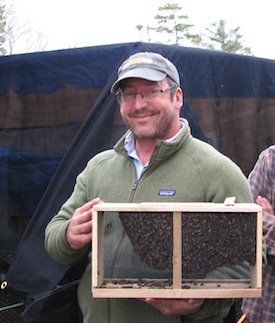Shop by Category
Shop by Brand
Shop by Brand
3# Package Bees
How Can I Buy Live Honey Bees Through The Mail?
|
|
|
Yes is the answer to all that!!!
A 3# package of bees is shipped in a screened/ventilated box.
It will look much like the one in the picture. It's about the size of a shoebox, with screening on both sides for good ventilation. The package will contain roughly 3 pounds of honey bees. That's approximately 10,000 honeybees, which is what it takes to get a brand new hive off to a good start. The package will also contain a food source for while the bees are in transit.
What about the queen bee?
The queen bee will be contained in a "queen cage" to keep her separate from the bees in the package while they travel. There will be several "attendant bees" in the cage with her. She will be unmarked. The queen cage will be attached inside the package, where the bees can cluster around the queen, drawn to her pheromones.
What kind of bees are these?
These are "mutt" bees. They are a mix of Italian (a very easy-going bee), Carniolan (considered quite industrious!), and Russian (with winter-hardy traits) genetics. We also like to call them "four-season" bees, as they are not raised in the deep south, where foraging is possible all year round. The bee yards are located in Maryland, Virginia, Carolinas, and northern Georgia.
How are live honey bees shipped through the mail?
Gold Star Honeybees are shipped USPS Priority Mail. They are only shipped via ground though - because the USPS prohibits air transportation of bees.
They are shipped “Hold for pickup” - and the post office will have your phone number. So be ready for a phone call from your post office asking you to "Come and get your bees!"
The USPS has a lot of experience shipping live bees (like about a hundred years worth!) They have a 95% success rate in getting your bees to you safely. Even when they are shipped cross-country. Even when they are in transit across the weekend. And each 3# package of honey bees is insured for your full purchase price.
How do I get the bees into my hive?
Here's an up-close and personal video, taking you step by step through the opening of the package and the shaking of the bees into your hive.
And here's a .pdf document with written instructions as well.
What do I do if my honey bees don't arrive safely?
This is why we insure your bees. Occasionally something goes wrong. In the event a package of bees arrives damaged, or with more than 1” of dead bees on the bottom, or if the queen bee is dead – then you, the purchaser are able to file a claim online with the USPS and to request reimbursement for the purchase price. Be sure to review our policies concerning your bee order here. Gold Star Honeybees cannot/will not file any claims. But we CAN provide copies of your purchase paperwork if you can't find yours, so reach out.
How do I know when to order my live honey bees to be shipped?
Bee hives need to be started at the same time as the honeybees' food sources begin to bloom in your area. So choose a date that's close to or just after the average last frost date in your area. Usually this coincides with the appearance of dandelions, and the blooming of early spring trees and flowers for your area, for instance, in Maine that means sugar maples, and pussy willows.
Not sure when the average last frost date is where you live? Visit the Farmer's Almanac website to learn more.
Some folks have also asked:
- Can I use a Gift Certificate to purchase your honey bees?
Of course you can, and gift certificates can be purchased here in any amount you like.

